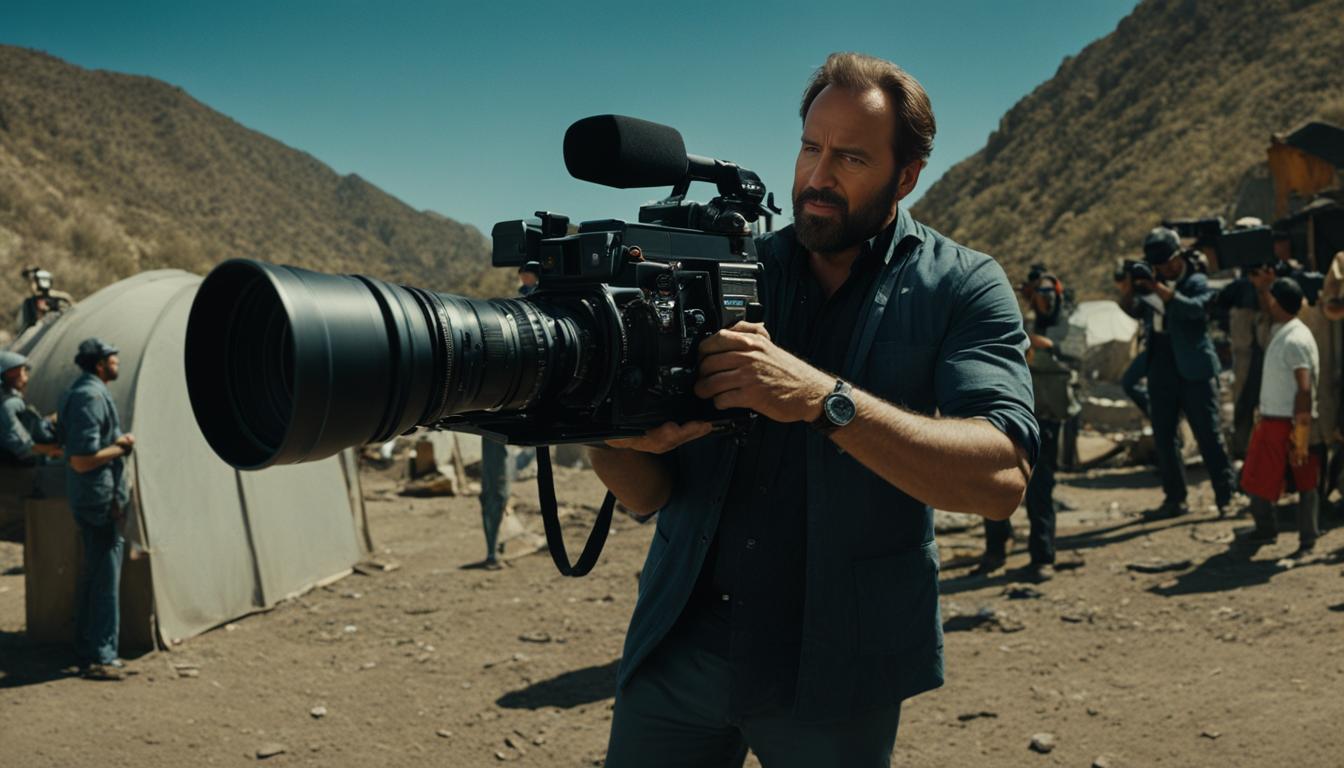Are you a film enthusiast looking for an insightful glimpse into the world of independent cinema? Look no further than Peter Biskind’s audiobook “Down and Dirty Pictures.” In this audiobook review, we explore the contents of Biskind’s captivating work, which follows the rise of two independent film powerhouses, Miramax and Sundance, and their impact on the film industry.
Through “Down and Dirty Pictures,” Biskind delves into the behind-the-scenes dealings, controversies, and creative triumphs of the indie film revolution. Get ready to uncover the history and legacy of Miramax and Sundance, and their contributions to the emergence of independent film as a major force in Hollywood.
Key Takeaways:
- Peter Biskind’s audiobook “Down and Dirty Pictures” offers a captivating insight into the rise of independent film and the impact of Miramax and Sundance on the film industry.
- The audiobook explores the history and legacy of these two film powerhouses, shedding light on the behind-the-scenes dealings, controversies, and creative triumphs of the independent film revolution.
- Biskind’s unique perspective as a film historian and journalist provides valuable context and analysis throughout the audiobook.
- The narration and audiobook experience enhance the listener’s understanding and enjoyment of the book.
- “Down and Dirty Pictures” is a must-listen for film enthusiasts and anyone interested in understanding the emergence of independent cinema as a major force in Hollywood.
The Indie Film Revolution
The indie film revolution marked a significant shift in the film industry, giving rise to a new wave of creativity and storytelling. Independent filmmakers challenged the traditional Hollywood model, which prioritized big-budget productions over artistry and originality. As a result, a new generation of filmmakers emerged, taking advantage of new technologies and distribution models to bring their stories to audiences.
The key to the indie film revolution was the focus on unconventional stories and characters, often drawn from real-life experiences and marginalized communities. This allowed for a greater diversity of voices and perspectives, challenging the dominant cultural narratives and expanding the possibilities of what cinema could achieve.
The impact of the indie film revolution goes beyond the films themselves. It paved the way for new business models and distribution strategies, giving filmmakers more control over their work and enabling them to reach wider audiences. It also created opportunities for actors, writers, and directors who were previously overlooked by the mainstream industry.
Today, independent film continues to thrive, offering a space for artistic and daring storytelling that challenges the status quo. Its legacy lives on, inspiring generations of filmmakers to embrace their creativity and push the boundaries of what cinema can achieve.
Meet Peter Biskind
Peter Biskind is an acclaimed author, film historian, and journalist who has extensively covered the film industry. Born on February 3, 1945, in New York City, Biskind grew up with a passion for cinema. He attended St. John’s College, where he studied classics and developed his passion for cultural history and criticism.
After college, Biskind began his career in journalism, writing for leading magazines such as Rolling Stone, Premiere, and Vanity Fair. His ability to provide insightful critiques and in-depth analysis of the film industry quickly earned him a reputation as one of the top film journalists in the business.
“Peter Biskind is one of the most astute and articulate writers about the film industry working today.” – Martin Scorsese
Biskind has since authored numerous books on film history, including “Easy Riders, Raging Bulls,” a definitive account of the golden age of Hollywood in the 1970s. However, his most influential work is undoubtedly “Down and Dirty Pictures,” which explores the rise of Miramax and Sundance and their impact on the independent film industry.
Through his extensive knowledge and experience in the film industry, Biskind provides a unique perspective on the rise of Miramax and Sundance. He details the intricate dealings and controversies behind the scenes and delves deep into the cutthroat nature of the film industry.
Biskind’s contribution to film history has been pivotal, and his expertise in journalism and film criticism has created a lasting impact on the industry. His work continues to inspire and educate film enthusiasts around the world.
Miramax: The Powerhouse Studio
Dive into the world of Miramax, the iconic film studio that pioneered independent filmmaking. Founded in 1979 by Harvey Weinstein and his brother Bob, Miramax quickly established itself as a force to be reckoned with in the entertainment industry. The studio took risks on low-budget indie films that other studios ignored, helping to launch the careers of filmmakers like Quentin Tarantino, Kevin Smith, and Steven Soderbergh.
Under Harvey’s leadership, Miramax became renowned for its aggressive Oscar campaigns, leading to numerous wins for acclaimed films like Pulp Fiction and The English Patient. However, allegations of sexual misconduct against Harvey Weinstein in 2017 tarnished the studio’s reputation and led to its eventual sale to a group of investors.
“What other studio in the history of the world has won more awards than the foreign-language department at Miramax?” – Harvey Weinstein
Despite the controversy, Miramax’s influence on independent filmmaking and the entertainment industry as a whole cannot be denied. The studio’s commitment to telling unique, character-driven stories has inspired countless filmmakers, and its impact on the film industry continues to be felt today.
Sundance: The Birthplace of Indie Hits
Founded in 1978 by Robert Redford, the Sundance Film Festival has become the ultimate platform for independent filmmakers to showcase their work. Over the years, the festival has gained a reputation for discovering and launching breakout hits, such as “Reservoir Dogs,” “Little Miss Sunshine,” and “Get Out.”
Sundance’s commitment to championing independent cinema has helped elevate the genre to international acclaim, making it a vital part of the film industry. The festival attracts over 120,000 attendees annually and is known for its vibrant atmosphere and diverse programming, which includes narrative and documentary features, shorts, and episodic content.
Sundance’s impact on the film industry is undeniable. It has launched the careers of numerous filmmakers, such as Steven Soderbergh, Quentin Tarantino, and Ava DuVernay, and has paved the way for indie films to gain recognition and acceptance in Hollywood. The festival continues to be a driving force for innovation and creativity, consistently pushing the boundaries of what is possible in independent cinema.

The Sundance Film Festival in Numbers
| Year Founded | 1978 |
|---|---|
| Number of Attendees | Over 120,000 |
| Number of Films | 200+ |
| Number of Countries Represented | 30+ |
| Average Budget of Selected Films | $1-3 million |
Down and Dirty Dealings
“Down and Dirty Pictures” offers a glimpse behind the scenes of the film industry, uncovering the controversies and struggles faced by independent filmmakers. The book highlights the cutthroat nature of the industry, especially at Miramax and Sundance, and how they pushed the boundaries to get their films made.
“The independent film industry is a rough business. It’s not for the faint of heart. You have to be tough to survive.” – Harvey Weinstein
One of the key themes explored in “Down and Dirty Pictures” is the tension between artistic integrity and commercial success. Independent filmmakers often had to navigate these challenges to get their films made and distributed. The book also delves into the controversy surrounding Harvey Weinstein, co-founder of Miramax, and the allegations of sexual harassment and abuse that came to light in 2017.
The book highlights the harsh realities of the film industry, including financing challenges, distribution struggles, and creative differences. Overall, “Down and Dirty Pictures” provides a revealing look at the challenges, controversies, and successes of independent filmmakers in the face of a cutthroat industry.
Impact and Legacy
Through “Down and Dirty Pictures,” Peter Biskind highlighted the impact and legacy of the independent film movement. This revolution transformed Hollywood by introducing new storytelling methods and distribution models, challenging the hegemony of the big studios.
The emergence of independent film production led to the recognition of talented filmmakers like Quentin Tarantino, Richard Linklater, and Kevin Smith. These directors brought fresh perspectives, diverse voices, and authentic stories to the big screen, breaking with the formulaic plots and stereotypical characters of mainstream cinema.
One of the most significant legacies of independent film was the establishment of more inclusive and diverse representation in the film industry. By creating opportunities for new voices and underrepresented groups, the indie film revolution paved the way for the growth and recognition of minority filmmakers and actors.

Overall, the impact and legacy of the independent film movement cannot be overstated. Its influence transformed the film industry, inspiring innovation, creativity, and a new era of storytelling.
Narration and Audiobook Experience
If you enjoy audiobooks, “Down and Dirty Pictures” is certainly worth a listen. Peter Biskind’s engaging writing style translates well to the audio format, and the narration by Johnathan Davis is top-notch. Davis captures the tone and pace of the book, keeping the listener engaged throughout. His clear enunciation and emphasis on important points enhance the listening experience, ensuring that the book’s themes and messages are not lost.
The audiobook also features interviews with prominent industry players, further enriching the listening experience. These insights provide a deeper understanding of the behind-the-scenes dealings and controversies depicted in the book. Overall, the audiobook is a great way to experience “Down and Dirty Pictures,” whether you’re a dedicated audiobook fan or looking to switch up your reading style.
So, grab a pair of headphones and immerse yourself in the world of independent film with Peter Biskind as your guide. The audiobook’s narration and expertly-crafted content make for a truly enjoyable listening experience.
Conclusion
In conclusion, “Down and Dirty Pictures” by Peter Biskind is a must-read book for film enthusiasts and anyone interested in the world of independent cinema. Biskind’s expertly crafted narrative sheds light on the rise of Miramax and Sundance, the indie film revolution, and the impact they had on the film industry.
The book also explores the controversies and challenges faced by independent filmmakers and provides a behind-the-scenes look into the cutthroat nature of the film industry. Biskind’s writing translates well to the audio format, and the audiobook experience enhances the listener’s understanding and enjoyment of the book.
Overall, “Down and Dirty Pictures” leaves a lasting impact, showcasing the legacy of the independent film movement and its transformational influence on Hollywood. It’s a fascinating read that provides an insightful glimpse into the world of independent film, and it’s well worth checking out.



